Entoloma caeruleum (P. D. Orton) Noordel.
Phylum: Basidiomycota - Class: Agaricomycetes - Order: Agaricales - Family: Entolomataceae
Distribution - Taxonomic History - Etymology - Identification - Culinary Notes - Reference Sources
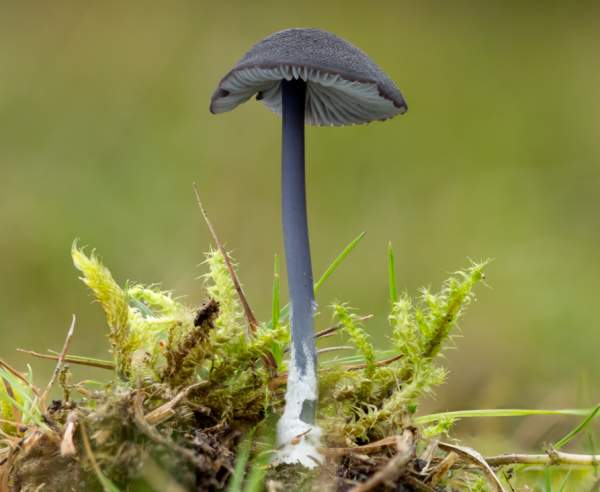
Entoloma caeruleum grows singly or in small groups in unimproved short-sward grassland..
Distribution
This rare pinkgill has been recorded in England, Wales, Scotland and Ireland, but it is a rare find and mostly recorded in the north. Elsewhere in Europe Entoloma caeruleum has been reported from parts of Scandinavia, including Denmark, as well as from Germany and Italy.
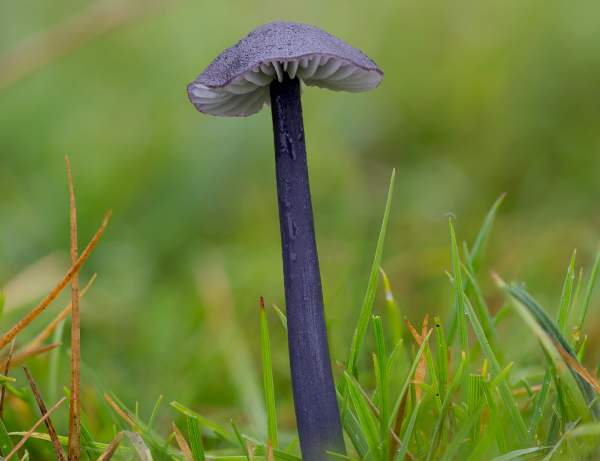
Taxonomic history
This beautiful mushroom was described scientifically in 1960 by British mycologist Peter Darbishire Orton, who gave it the scientific name Leptonia caerulea. The currently-accepted scientific name Entoloma caeruleum dates from a 1980 publication by Dutch mycologist Machiel Evert Noordeloos (b. 1949).
Apart from Leptonia caeruleum, this species appears to have no other synonyms.
Etymology
The generic name Entoloma comes from ancient Greek words entos, meaning inner, and lóma, meaning a fringe or a hem. It is a reference to the inrolled margins of many of the mushrooms in this genus.
The specific epithet caeruleum means dark blue.
Identification guide
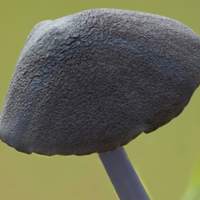 |
CapThe cap of Entoloma caeruleum is convex and becoming flattened and slightly umbilicate; blackish blue, becoming paler at the margin and eventually fading to violaceous brown; fibrillose or finely squamulose; 1 to 5cm in diameter; margin not striate. PileipellisA cutis or a trichoderm of inflated terminal elements 6-20μm diameter; clamps absent. |
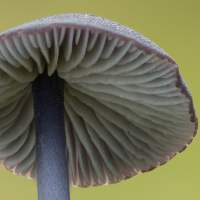 |
GillsWhite or yellowish at first, becoming pink and sometimes spotted with yellow; adnate-emarginate, moderately spaced; gill edge sterile; cheilocystidia abundant, cylindrical to clavate; 20-25 x 4-16μm. |
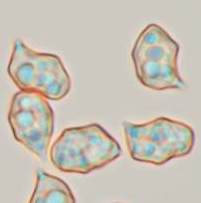 |
SporesHeterodiametrical with 5 to 7 sides; 9-11.5 x 6-7.5µm. Spore printPale pink. |
Stem |
Cylindrical, sometimes slightly flattened and grooved, smooth, shiny, 1.5 - 5cm long x 1-5mm diameter; blue-black with a lilaceous tinge; white at the base; flesh blue-grey. |
Odour/taste |
Odour indistinct or slightly sweet; taste not distinctive. |
Habitat & Ecological role |
Solitary or in very small groups in unimproved grassland, particularly sand-dune slacks with creeping willow, . |
Season |
Summer and autumn. |
Occurrence |
Rare. |
Similar species |
There are several 'blue' mushrooms in the Entoloma genus, including Entoloma serrulatum, which has black flecked serrulate (finely saw-toothed) gill edges. |
Culinary Notes
Entoloma caeruleum is rare and has no culinary value.
Reference Sources
Entoloma caeruleum (P.D. Orton) Noordel., Persoonia 11: 470 (1982)
Leptonia caerulea P.D. Orton, Transactions of the British Mycological Society 43 (2): 290 (1960)
Fascinated by Fungi, 2nd Edition, Pat O'Reilly 2016, reprinted by Coch-y-bonddu Books in 2022.
Knudsen H., Vesterholt J. (eds) Funga Nordica: agaricoid, boletoid and cyphelloid genera - Nordsvamp, 2008
Dictionary of the Fungi; Paul M. Kirk, Paul F. Cannon, David W. Minter and J. A. Stalpers; CABI, 2008
Taxonomic history and synonym information on these pages is drawn from many sources but in particular from the British Mycological Society's GB Checklist of Fungi.
Acknowledgements
This page includes pictures kindly contributed by David Kelly.
Fascinated by Fungi. Back by popular demand, Pat O'Reilly's best-selling 450-page hardback book is available now. The latest second edition was republished with a sparkling new cover design in September 2022 by Coch-y-Bonddu Books. Full details and copies are available from the publisher's online bookshop...


